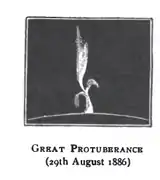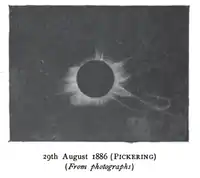Solar eclipse of August 29, 1886
A total solar eclipse occurred on August 29, 1886. A solar eclipse occurs when the Moon passes between Earth and the Sun, thereby totally or partly obscuring the image of the Sun for a viewer on Earth. A total solar eclipse occurs when the Moon's apparent diameter is larger than the Sun's, blocking all direct sunlight, turning day into darkness. Totality occurs in a narrow path across Earth's surface, with the partial solar eclipse visible over a surrounding region thousands of kilometres wide.
| Solar eclipse of August 29, 1886 | |
|---|---|
 Map | |
| Type of eclipse | |
| Nature | Total |
| Gamma | −0.1059 |
| Magnitude | 1.0735 |
| Maximum eclipse | |
| Duration | 396 sec (6 m 36 s) |
| Coordinates | 3.5°N 15.3°W |
| Max. width of band | 240 km (150 mi) |
| Times (UTC) | |
| Greatest eclipse | 12:55:23 |
| References | |
| Saros | 133 (38 of 72) |
| Catalog # (SE5000) | 9249 |
Observations
 |
 |
 |
 |
References
- NASA graphic
- Mabel Loomis Todd (1900). Total Eclipses of the Sun. Little, Brown.
Wikimedia Commons has media related to Solar eclipse of 1886 August 29.
This article is issued from Wikipedia. The text is licensed under Creative Commons - Attribution - Sharealike. Additional terms may apply for the media files.
.jpg.webp)

